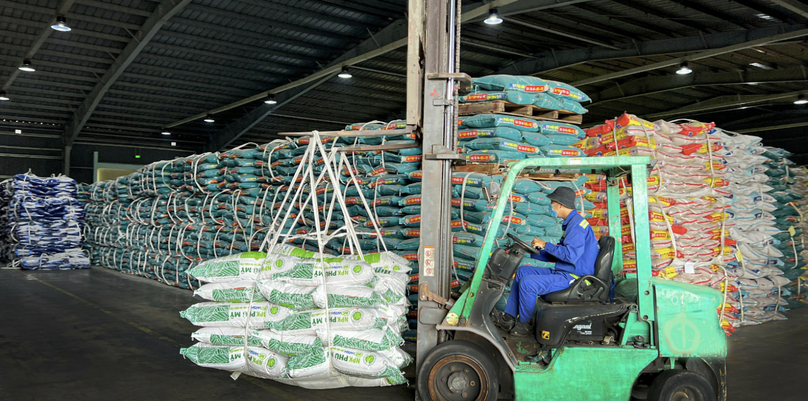Flexibility, acumen key drivers of fertilizer industry
Difficulties face all fertilizer industry players this year, and the winner will be the one who knows how to deal with adverse impacts, says Cao Trung Kien, vice president of the Petrovietnam Fertilizer & Chemicals Corporation (PVFCCo).
PVFCCo achieved record results in 2022, with revenue of nearly VND20 trillion ($853 million) and pre-tax profit of over VND6.4 trillion ($273 million). What were the driving forces of these outcomes?
Global geopolitical instabilities kept fertilizer prices high for most of 2022 and they only cooled down in the fourth quarter. The increase in world fertilizer prices led to higher domestic prices, positively impacting PVFCCo's revenue and profit. However, the most important point was that the corporation seized opportunities, ensured safety and efficiency in production, and showed flexibility in business and acumen to make optimal decisions based on market fluctuations.
Specifically, PVFCCo set a record for continuous operation with an output of about 1.15 million tons of fertilizers and chemicals of all kinds, including nearly 920,000 tons of urea, 120,000 tons higher than the designed capacity. Continuous operations helped the firm save a lot of energy and material costs.
In addition to meeting domestic demand, the company took advantage of the high world prices to boost exports. PVFCCo’s urea exports in 2022 reached nearly 200,000 tons, four times higher than the plan and accounting for a quarter of its total urea sales. This made an important contribution to easing pressure on the domestic market, increasing revenue and profit, and bringing in a significant amount of foreign currency.
Looking back, it can be seen that besides the objective reasons for favorable prices, the most important subjective factor that helped PVFCCo achieve business results far beyond our plans was the human factor, with great efforts in production as well as acumen and business flexibility.
Are these favorable factors sustainable and what are PVFCCo’s response plans for 2023?
The objective favorable factors are, of course, not sustainable. PVFCCo has clearly identified difficulties and challenges in 2023. Compared to the peak of 2022, now the price of urea has more than halved, while the prices of input materials for production remain high. Fertilizer demand in the domestic and international markets has been met, with the total capacity of fertilizer plants far exceeding the total demand, and competition is getting fiercer.
Once the Covid-19 epidemic and the world political-economic crisis caused by the Russia-Ukrainia conflict are over, and logistics activities return to normal, fertilizer supply will increase dramatically, pulling prices down. Falling prices will stimulate demand, but on the other hand, make dealers and final buyers hesitate to make purchasing decisions, hindering sales.
However, these difficulties will be shared by all. The important thing is how to cope with their adverse impacts, and make the best use of positive effects. PVFCCo has prepared scenarios to deal with all situations. Under any circumstances, our factories must ensure continuous, safe and efficient operations, turning out maximum output with the highest quality. Business and logistics must run smoothly, without any disruption at any stage, for timely supply to farmers at the lowest costs, contributing to stabilizing the market and maintaining market share.
At the same time, we will continue to focus on management; reduce production costs, energy consumption and material consumption; and lower product prices to improve business efficiency.
In the long term, PVFCCo will adjust activities related to corporate governance, focusing on building a competitive strategy, expanding new breakthrough products, and promoting digital transformation. These are urgent requirements to making a breakthrough for PVFCCo not only in 2023 but also the following years.

A worker at the Petrovietnam Fertilizer & Chemicals Corporation plant in Phu My Industrial Park, Ba Ria-Vung Tau province, southern Vietnam. Photo courtesy of the company.
The Ministry of Finance has proposed a plan to adjust the export tax rates on fertilizers, including a 5% rate for urea, phosphate, superphosphate, DAP and MAP products and 0% for NPK. Will this affect PVFCCo’s production and business activities?
According to current regulations, exported fertilizers are divided into two groups. Fertilizers with natural resource and mineral values and energy costs below 51% of their prices are subject to an export tax rate of 0%. Meanwhile, a tax rate of 5% is imposed on the remainder.
PVFCCo's urea products have been subject to a 5% export tax rate for many years. Therefore, the Ministry of Finance's proposal, once approved, will not affect the production and business activities of the company.
In 2023, what is PVFCCo’s export target and what are its key markets?
In 2022, PVFCCo achieved its best ever export results, but with the mission to ensure the country's food security, the corporation always prioritizes serving the Vietnamese agricultural industry and meeting the needs of domestic farmers, thus maintaining its market share in the long run.
Only in times of reduced domestic demand will it consider exports to balance supply and demand, free up inventories, and bring foreign currency to the country. When there are conditions for exports, PVFCCo is likely to give priority to traditional markets such as India and South Korea.
